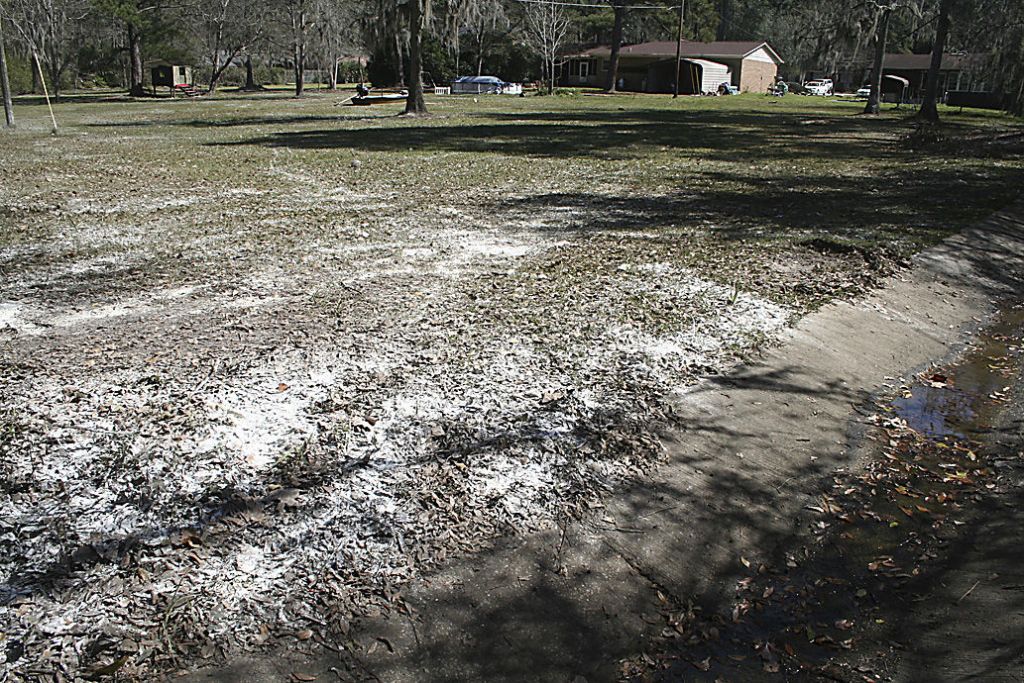FEMA denies funding request
Published 2:00 pm Sunday, March 10, 2013

- Volunteers and City workers spread lime sparingly on portions of an open property behind Meadowbrook in Valdosta, but not everywhere that was soaked with floodwater. Residents feel unsatisfied with this treatment of sewage-tainted stormwater given the proximity of a manhole that overflows often.
The City of Valdosta applied to the Federal Emergency Management Agency in 2009 requesting assistance to relocate and rebuild the Withlacoochee Wastewater Treatment Plant (WWTP), also referred to as the Pollution Control Plant (WPCP). According to a letter from FEMA in December 2010, the agency presented three mitigation proposals:
1. Relocate the facility at an estimated cost of $94 million.
2. Construct an earthen berm around certain portions of the facility, construct a stormwater collection and pumping station within areas behind the berm, and construct an effluent pumping station to discharge effluent during flooding events at a cost of approximately $4.1 million.
3. Construct flood barriers around the chlorine and dewatering buildings, construct a flood barrier around the influent pump station, place dewatering pumps within the areas behind the berm, and increase the height of the tertiary filtration system walls to five feet at a cost of approximately $1.1 million.
The letter states that the city has “indicated they want to relocate the facility and do not wish to pursue options two and three.”
According to the FEMA letter, following the April 2009 flood event, they prepared a project worksheet in the amount of $527,183.70 to document identified damages and estimated repairs to the plant. Also, a proposed floodwall around the plant at a cost of $33 million was not cost effective.
FEMA denied the city’s application for the $94 million cost to relocate and rebuild the plant on the basis that it wasn’t cost effective and applied to undamaged elements of the facility. The city appealed the decision in February 2011.
According to documents obtained in an open records request, the appeal was based on the fact that the local Lowndes County ULDC (Unified Land Development Code) and flood-plain ordinances, along with International Building Codes and FEMA’s own flood-plain management directives prohibit the city from making substantial improvements or repairs at the current location.
In the appeal letter, Deputy City Manager John Whitehead states, “The declared event was not the first, nor the only time the WPCP has flooded. In fact, its low flood-plain elevation has led to a number of permit violations:
“Between October 1993 and August 2010, 21 separate events led to 123 total days of flood levels exceeding 122 feet or greater in elevation. This means the WPCP is under flooding an average of 7.2 days per year, including the 2009 declared event, which reached an elevation of 137 feet at maximum river stage.
“Each of these flooding events put the community at risk. Many flooding events resulted in the discharge of raw sewage outside the controlled system, threatening the health of the community and the integrity of the river, its ecosystem and other downstream persons and communities. The damage and the risks will continue unabated if significant hazard mitigation measures are not put in place.”
This first appeal was denied by FEMA again, according to FEMA documents, as it was not cost effective to spend $94 million when the plant sustained $527,000 in damages.
The city appealed the decision a second time in February 2012, this time requesting $88 million to relocate and rebuild the plant, and was again denied by FEMA in July 2012 citing FEMA’s Disaster Assistance Policy, Hazard Mitigation Funding Under Section 406 (Stafford Act), dated July 30, 2007.
The FEMA policy states, “If mitigation measures are approved for the repair of a disaster-damaged facility and the subgrantee requests an improved project which will instead involve the replacement of the facility, on the same site or an alternate site, the cost of the mitigation measures is not eligible.”
When asked if the city could find any other wastewater plant relocations that had been funded by FEMA, Whitehead said there were none, and the city’s would have been the first.
In an interview in February of this year prior to the current flooding event, city officials stated that despite the FEMA rejections, the plant has to be moved and the city has to find a way to pay for it out of local funds and a proposed SPLOST (special purpose local option sales tax). The figure to rebuild the plant is now roughly $20 million with an additional $32 million for a major force main project to replace the gravity lines, for which the city has obtained a $32 million GEFA loan.
City officials stated that the plant cannot be substantially repaired or improved in its current state as the county’s ULDC prohibits them from doing so since it’s in a flood plain. According to the county, the ULDC does prohibit it, but the city is also eligible to request a variance to make those repairs and has not done so.





